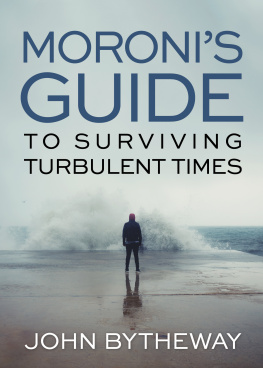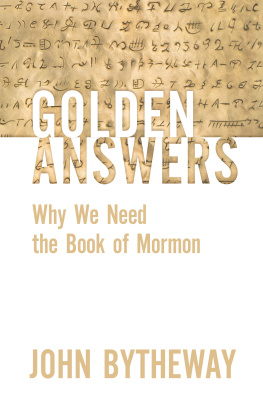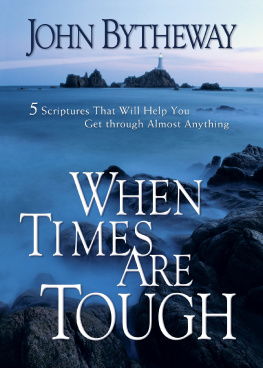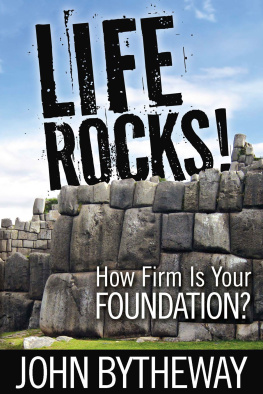Interior graphic Strilets/Shutterstock.com
2017 John Bytheway
All rights reserved. No part of this book may be reproduced in any form or by any means without permission in writing from the publisher, Deseret Book Company, at permissions@deseretbook.com or P. O. Box 30178, Salt Lake City, Utah 84130. This work is not an official publication of The Church of Jesus Christ of Latter-day Saints. The views expressed herein are the responsibility of the author and do not necessarily represent the position of the Church or of Deseret Book Company.
Deseret Book is a registered trademark of Deseret Book Company.
Visit us at DeseretBook.com
Library of Congress Cataloging-in-Publication Data
Names: Bytheway, John, 1962 author.
Title: Moronis guide to surviving turbulent times / John Bytheway.
Description: Salt Lake City, Utah : Deseret Book, [2017] | Includes bibliographical references.
Identifiers: LCCN 2017040437 | ISBN 9781629722511 (paperbound)
Subjects: LCSH: MormonsConduct of life. | Christian lifeMormon authors. | Book of Mormon. MoroniCriticism, interpretation, etc. | Moroni (Book of Mormon figure)
Classification: LCC BX8656 .B886 2017 | DDC 248.4/89332dc23
LC record available at https://lccn.loc.gov/2017040437
Printed in the United States of America
PubLitho, Draper, UT
10 9 8 7 6 5 4 3 2 1
COVER ART CREDITS
Book design Deseret Book Company
Cover photo GaudiLab/Shutterstock.com
Design: Shauna Gibby
Chapter One
Meet Moroni

One memorable evening, after participating in a fireside in Tremonton, Utah, I strapped myself into my little Hyundai and set out for the drive home. As I proceeded southbound along the Wasatch Front, I marveled at the number of temples I passed along the way.
I thought about each one I might see if I continued down the I-15 corridor, naming them in my mind: Brigham City, Ogden, Bountiful, Salt Lake, Jordan River, Oquirrh Mountain, Draper, Timpanogos, Provo, Payson, and so forth.
When I was a missionary in the early 1980s, part of the standard equipment was a flip chart containing visual aids, quotations, and pictures. One of the illustrations showed all the temples then in existencethere were sixteen, all on one page, and I could name them all from memory. I couldnt possibly name them all today!
On April 6, 1930, the one-hundred-year anniversary of the organization of the Church, Elder B. H. Roberts told the Saints gathered in general conference:
Seven temples have been erected in various parts of the land of Zion, for a continuance of this holy work, and more will yet be builded. Think what that work may be when there are a hundred temples instead of seven! (In Conference Report, April 1930, 47)
It must have been hard to fathom back then, but here we are, still some years away from the Churchs second hundred years, and there are more than 150 temples!
But the thought that wouldnt leave me as I drove that evening was not so much about the buildings. It was about the man, the icon standing atop nearly all of our templesthat solitary figure, the angel Moroni. There he was, all alone, looking out over the valleys like the watchman on a tower that he was. It occurred to me that being alone was something with which Moroni was painfully familiar.
My mind began to race. This may be a family church, I thought, but it was restored through an unmarried teenager who was visited and tutored by an angelwho spent at least the last twenty years of his life as a single adult, alone and wandering for his own safety. Moroni is one of the symbols of our membership. He is on the cover of For the Strength of Youth, Personal Progress, and Duty to God. How much different would the Book of Mormon be without Moronis work? I had the thought, Moronis best work was done while he was a single adult an affirming, comforting, and motivating fact for a large population within our Church. Marital status does not increase or diminish our ability to contribute, and it does not change what the Lord expects of us.
We know that there was limited space on the plates, so what Moroni shared was what was most important to him and what he felt inspired would be important to us. So what was on Moronis mind as he concluded the Book of Mormon?
I find it fascinating to consider Moronis unique perspective as I ponder what he wrote to us while in extremely difficult, lonely, and sorrowful circumstances. We might call it Moronis last lecture, his final, best advice he had to offer as a voice from the dust.
Not only is Moronis choice of topics interesting, but the sequence in which they are shared is very instructive, almost like a list of priorities for life. We first hear the voice of Moroni as he begins writing in Mormon 8, and he finishes the book named after his father in Mormon 9. Next, he abridges the book of Ether into fifteen concise chapters. Finally, Moroni concludes the record with ten chapters called the book of Moroni.
This little book will consider Moronis final contribution, what we might call his survival guidean exploration of Moronis inspired topics in an inspired sequence, a formula for what we must do to survive and thrive in our turbulent world with all of its challenges. Think about it: ours is a world not unlike Moronis, full of chaos and violence and seemingly teetering on the brink of destruction. If we can develop a Moroni mind-set, we will navigate those trials more effectively, as he did.
This book is partly a commentary, partly a tribute to Moroni, and partly an effort to liken Moronis message. For this reason, each chapter will conclude with a section labeled Likening Moroni, a brief list of ways we might liken Moronis words in that chapter to ourselves (see 1 Nephi 19:23), ways we might apply them as we wander for our own spiritual safety through this latter-day world.
Chapter Two
Mormon 8
I Am Alone

Moronis father, Mormon, was the major abridger of the Book of Mormon, which is why the book appropriately bears his name. One wonders if Moroni had any idea that he would suddenly be called upon to finish his fathers work. Given the circumstances, he was in fact the only one who could finish the record. The events that overtook him and left his family dead seemed to have come as a surprise. Mormon did not die of natural causes. He was killed in battle at age seventy-three, and so he was not around to finish his book. This is why Mormon chapter 8 begins with these words:
Behold I, Moroni, do finish the record of my father, Mormon. Behold, I have but few things to write, which things I have been commanded by my father.
We are left to wonder if this father and son were together at the moment Mormon died, or when exactly Moroni received these last instructions. We dont know. Regardless, Moroni knows he must finish the work his father began.
These first few verses in Mormon 8 contain no doctrine to speak of, just an outpouring of emotion and grief. Moroni talks to future generations, using those yet unborn as a sounding board, it seems, as he assesses his own situation with this sobering list of facts (Mormon 8:35):
















